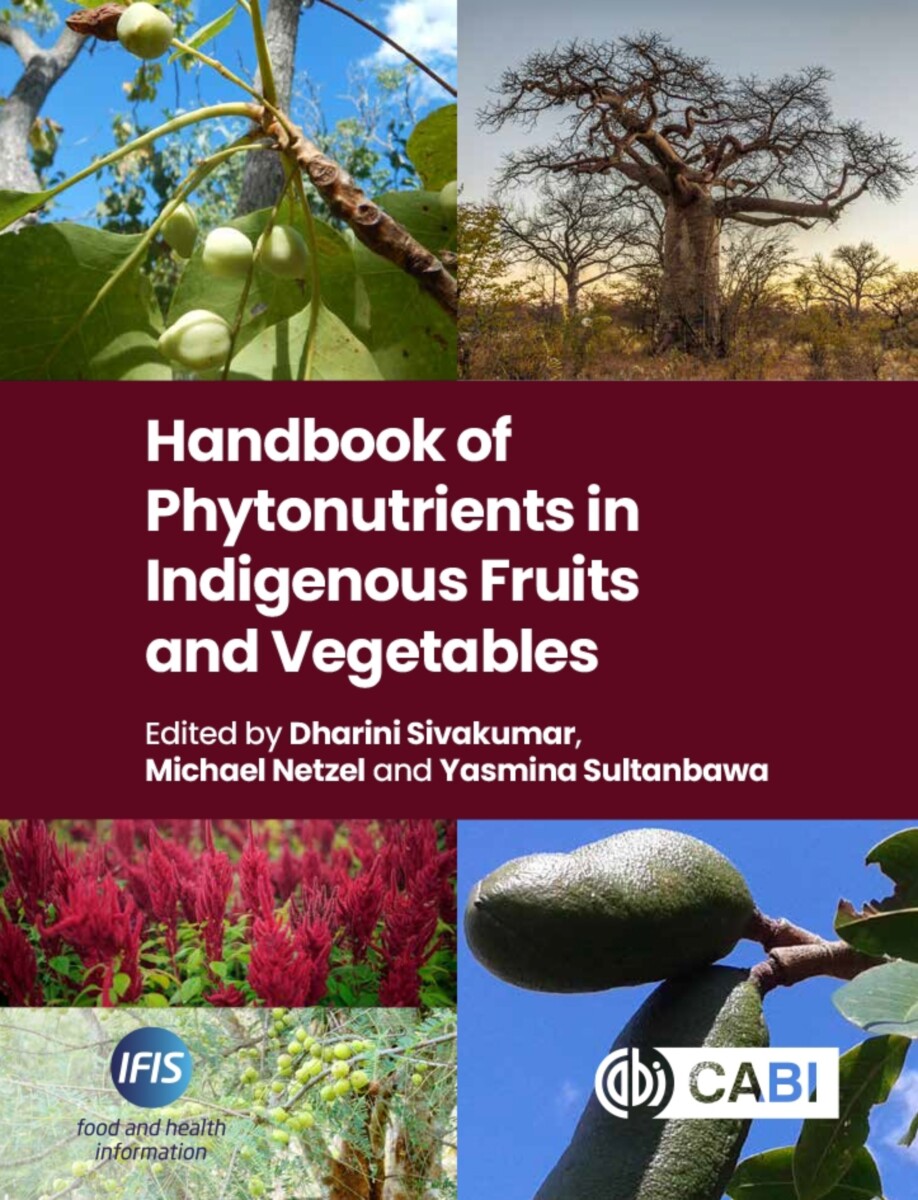Handbook of Phytonutrients in Indigenous Fruits and Vegetables
- Publisher
CABI - Published
27th March 2023 - ISBN 9781789248043
- Language English
- Pages 448 pp.
- Size 6" x 9"
The effects of inadequate diets on the population include malnutrition, non-communicable diseases and obesity. "Hidden hunger," also known as micronutrient deficiency, leads to various health-related disorders and diseases. Indigenous plants, in the form of indigenous fruits and leafy vegetables are gaining interest as a source of nutrients and bioactive phytochemicals, satisfying both food demand and health needs.
Moreover, with the impact of climate change, and the importance of sustainability of food systems, it is essential that we investigate new, forgotten and alternative crops that can thrive in harsh conditions, require low fertilizer input, and are easily harvestable.
This book contains chapters on 33 understudied indigenous fruits and vegetables from all around the world, including African nightshade, amaranth, baobab fruit, Indian gooseberry, red bush apple, and snake melon. Each chapter provides:
- An overview of plant botany
- An understanding of the phytonutrient constituents and health-promoting properties of bioactive compounds or metabolites
- Information on the biological activity of the functional compounds that will improve productivity and increase utilization of indigenous fruits and vegetables to sustain food security
- Impacts of postharvest storage, processing, and traditional food preparation methods
- Potential for new product development
Chapter 1: Salt bush (Atriplex spp.)
Chapter 2: Gumby Gumby (Pittosporum Angustifolium)
Chapter 3: Spider Plant (Cleome gynandra)
Chapter 4: Amaranth (Genus Amaranthus)
Chapter 5: African Pumpkin (Momordica balsamina)
Chapter 6: Pumpkin leaves (Cucurbita maxima, Cucurbita moschata and Cucurbita pepo)
Chapter 7: African Nightshade (Solanum nigrum complex species)
Chapter 8: Moringa (Moringa oleifera)
Chapter 9: Sweet Potato Leaves and its Role in Human Nutrition (Ipomoea batatas [L.] Lam)
Chapter 10: Coral Tree (Erythrina variegata), an Indigenous Plant of Bangladesh
Chapter 11: A Focus on Snake Melon: Agronomic Traits and Functional Quality of Snake Melon (Cucumis melo var. flexuosus)
Chapter 12: Kakadu Plum (Terminalia ferdinandiana)
Chapter 13: Lilly pilly/Riberry (Syzygium spp.)
Chapter 14: Australian Green Plum (Buchanania obovata)
Chapter 15: Red Bush Apple (Syzygium suborbiculare)
Chapter 16: Passion Fruit (Passiflora edulis)
Chapter 17: Baobab (Adansonia digitata L.)
Chapter 18: Jatobá (Hymenaea courbaril L.) fruit
Chapter 19: Ora-pro-nobis (Pereskia aculeata Miller) leaf and fruit
Chapter 20: Bacupari Fruit (Garcinia brasiliensis Mart)
Chapter 21: Monkey jack (Dewa) (Artocarpus lakoocha), an Indigenous fruit of Bangladesh
Chapter 22: Black plum fruit (Vitex doniana)
Chapter 23: Natal plum fruit (Carissa macrocarpa)
Chapter 24: Brazilian Cherry (Eugenia uniflora L.)
Chapter 25: Monkey Orange (Strychnos spinosa Lam)
Chapter 26: African Star Apple (Chrysophyllum albidum)
Chapter 27: Phalash (Grewia asiatica)
Chapter 28: Phytonutrients of Mexican Plum (Spondias purpurea L.)
Chapter 29: Phytonutrients of Soursop (Annona muricata)
Chapter 30: Dabai (Canarium odontophyllum)
Chapter 31: Mamey Sapote (Pouteria sapota (Jacq.)
Chapter 32: Araçá Fruits (Psidium cattleianum Sabine)
Chapter 33: Indian Goose Berry (Amla) (Phyllanthus emblica)
Dharini Sivakumar
Professor Dharini Sivakumar, Tshwane University of Technology, South Africa, obtained the prestigious South African Research Chair (SARChI) funding from the Department of Science and Innovation (DSI) / National Research Foundation (NRF) for “Phytochemical Food Network to Improve Nutritional Quality for Consumers.” She has established a working program with the rural African communities to promote cultivation and agro processing of traditional vegetables and fruits in Venda, South Africa, which helped to develop entrepreneur skills, creation of employment, income generation and poverty alleviation.
Michael Netzel
Dr. Michael Netzel’s (The University of Queensland, Australia) main research interests are related to phytochemicals/functional ingredients, their analytical determination, binding characteristics within the plant (food) matrix, structural modifications/degradation during processing and digestion, bioaccessibility as well as bioavailability and metabolism (“from the raw produce to the absorbed and metabolized bioactive compound”). Understanding in vitro bioaccessibility (matrix release and availability for intestinal absorption) as well as the much more complex in vivo bioavailability (including microbial degradation in the gut) of dietary phytochemicals are crucial in understanding and predicting their bioactivity and potential health benefits in humans. Assessing the “nutritional value” of Australian grown (native and non-native) fruits and vegetables in the context of a diverse, sustainable and healthy diet is the current focus of his research.
Yasmina Sultanbawa
Associate Professor Yasmina Sultanbawa, The University of Queensland, Australia, has established a Training Center funded by the Australian Research Council, that aims to transform the native Food and Agribusiness Sector through development of selected crops, foods and ingredients using an Indigenous governance group to oversee the process of converting Traditional Knowledge into Branded Products. Her research is focused within the agribusiness development framework, specifically in the area of food processing, preservation, food safety and nutrition. Her current research includes the minimization of post-harvest losses through value addition and the search for natural preservatives to replace current synthetic chemicals. In addition, her research area also includes the challenge of nutrition security, micronutrient deficiency (hidden hunger), lack of diet diversity and nutritional losses in the food supply chain, which are addressed by her work with underutilized Australian plant species and potential new crops. Her work on Australian native plant foods is focused on incorporation of these plants in mainstream agriculture and diet diversification. Working with indigenous communities to develop nutritious and sustainable value-added products from native plants for use in the food, feed, cosmetic and health care industries is a key strategy. The creation of employment, economic and social benefits to these remote communities is an anticipated outcome. She has established a Training Center funded by the Australian Research Council, that aims to transform the native Food and Agribusiness Sector through development of selected crops, foods and ingredients using an Indigenous governance group to oversee the process of converting Traditional Knowledge into Branded Products.


